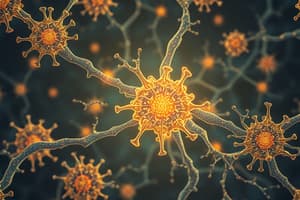Podcast
Questions and Answers
What is the primary difference between sensation and perception?
What is the primary difference between sensation and perception?
- Perception involves interpreting sensory information. (correct)
- Sensation is the process of organizing sensory information.
- Perception does not involve sensory receptors.
- Sensation is only related to external stimuli.
Which of the following best describes bottom-up processing?
Which of the following best describes bottom-up processing?
- Using prior knowledge to interpret incoming sensory information.
- Analyzing sensory input starting from the smallest units. (correct)
- Integrating sensory information to form a complete picture.
- Filtering sensory input based on relevance.
Why do we have more than five senses according to scientific evidence?
Why do we have more than five senses according to scientific evidence?
- Other senses like proprioception and equilibrioception are mediated by specialized receptors. (correct)
- The number of senses depends on individual perception.
- Only five distinct sensory modalities exist.
- Senses correspond only to traditional classifications.
What role do nociceptors serve in the sensory system?
What role do nociceptors serve in the sensory system?
How does the brain generally code for stimulus intensity?
How does the brain generally code for stimulus intensity?
What is meant by the term 'receptive field' in sensory processing?
What is meant by the term 'receptive field' in sensory processing?
What does the plasticity of the brain refer to?
What does the plasticity of the brain refer to?
Which of the following correctly states a reason why our sensation diminishes with constant stimulation?
Which of the following correctly states a reason why our sensation diminishes with constant stimulation?
What is the primary function of sensory receptor organs?
What is the primary function of sensory receptor organs?
What concept explains how specific nerves convey different senses?
What concept explains how specific nerves convey different senses?
What mechanism demonstrates how receptor potentials lead to action potentials?
What mechanism demonstrates how receptor potentials lead to action potentials?
What is the role of the Pacinian corpuscle?
What is the role of the Pacinian corpuscle?
Which phenomenon describes the progressive loss of response to a constant stimulus?
Which phenomenon describes the progressive loss of response to a constant stimulus?
What do graded potentials in sensory neurons typically initiate?
What do graded potentials in sensory neurons typically initiate?
What does intensity coding in sensory systems rely on?
What does intensity coding in sensory systems rely on?
Where are the cell bodies of the neurons connected to the Pacinian corpuscle located?
Where are the cell bodies of the neurons connected to the Pacinian corpuscle located?
What is the primary function of tonic receptors?
What is the primary function of tonic receptors?
Which brain structure is primarily responsible for processing touch information before reaching the cerebral cortex?
Which brain structure is primarily responsible for processing touch information before reaching the cerebral cortex?
What does the term 'somatotopic organization' refer to in the primary somatosensory cortex?
What does the term 'somatotopic organization' refer to in the primary somatosensory cortex?
Which phenomenon helps in the recovery of function after cortical damage through repurposing neurons?
Which phenomenon helps in the recovery of function after cortical damage through repurposing neurons?
What is a characteristic of phasic receptors?
What is a characteristic of phasic receptors?
How does the cortical representation of touch differ for highly used areas?
How does the cortical representation of touch differ for highly used areas?
What does the concept of 'phantom limbs' illustrate in the context of the brain's plasticity?
What does the concept of 'phantom limbs' illustrate in the context of the brain's plasticity?
Which of the following best describes 'constraint-induced therapy'?
Which of the following best describes 'constraint-induced therapy'?
Which part of the brain is critical for enhancing processing of unattended information?
Which part of the brain is critical for enhancing processing of unattended information?
What does synesthesia exemplify in terms of sensory processing?
What does synesthesia exemplify in terms of sensory processing?
How is congenital insensitivity to pain caused?
How is congenital insensitivity to pain caused?
Pain serves various functions; which of the following is NOT one of them?
Pain serves various functions; which of the following is NOT one of them?
What type of receptors are TRPV1 and TRPM3 associated with?
What type of receptors are TRPV1 and TRPM3 associated with?
Which phenomenon is linked with evolutionarily conserved processes?
Which phenomenon is linked with evolutionarily conserved processes?
The McGill Pain Questionnaire is effective for assessing which aspect of pain?
The McGill Pain Questionnaire is effective for assessing which aspect of pain?
What is a characteristic feature of the 'association cortex'?
What is a characteristic feature of the 'association cortex'?
Which type of pain is characterized by a heightened sensitivity in dorsal horn neurons after damage?
Which type of pain is characterized by a heightened sensitivity in dorsal horn neurons after damage?
What common receptor do all itch cells share?
What common receptor do all itch cells share?
Which structure is responsible for endogenous analgesic effects by blocking incoming pain signals?
Which structure is responsible for endogenous analgesic effects by blocking incoming pain signals?
Which of the following is NOT a pathway involved in pain sensation?
Which of the following is NOT a pathway involved in pain sensation?
How do painkillers reduce the perception of social rejection?
How do painkillers reduce the perception of social rejection?
Which class of drugs is primarily associated with analgesic effects at higher brain sites?
Which class of drugs is primarily associated with analgesic effects at higher brain sites?
What factor can influence the efficacy of a placebo in pain management?
What factor can influence the efficacy of a placebo in pain management?
What is the role of NSAIDs in pain management?
What is the role of NSAIDs in pain management?
Flashcards
Sensation
Sensation
The process of receiving sensory information from the environment through specialized receptor cells.
Perception
Perception
The process of interpreting and organizing sensory information to make sense of the world.
Bottom-up processing
Bottom-up processing
Processing that begins with sensory input and works its way up to higher levels of processing in the brain.
Top-down processing
Top-down processing
Signup and view all the flashcards
Transduction
Transduction
Signup and view all the flashcards
Receptive field
Receptive field
Signup and view all the flashcards
Brain plasticity
Brain plasticity
Signup and view all the flashcards
Attention
Attention
Signup and view all the flashcards
Doctrine of Specific Nerve Energies
Doctrine of Specific Nerve Energies
Signup and view all the flashcards
Labelled Lines
Labelled Lines
Signup and view all the flashcards
Sensory Receptor Organs
Sensory Receptor Organs
Signup and view all the flashcards
Restricted Range of Responsiveness
Restricted Range of Responsiveness
Signup and view all the flashcards
Graded Potentials
Graded Potentials
Signup and view all the flashcards
Action Potentials
Action Potentials
Signup and view all the flashcards
Intensity Coding
Intensity Coding
Signup and view all the flashcards
Tonic Receptors
Tonic Receptors
Signup and view all the flashcards
Phasic Receptors
Phasic Receptors
Signup and view all the flashcards
Four main skin receptors
Four main skin receptors
Signup and view all the flashcards
Afferent axons from skin receptors
Afferent axons from skin receptors
Signup and view all the flashcards
Dorsal Column System
Dorsal Column System
Signup and view all the flashcards
Dermatome
Dermatome
Signup and view all the flashcards
Primary Somatosensory Cortex (S1)
Primary Somatosensory Cortex (S1)
Signup and view all the flashcards
Aδ fibers
Aδ fibers
Signup and view all the flashcards
CMR1
CMR1
Signup and view all the flashcards
C fibers
C fibers
Signup and view all the flashcards
Itch
Itch
Signup and view all the flashcards
Spinothalamic system
Spinothalamic system
Signup and view all the flashcards
Phantom limb pain
Phantom limb pain
Signup and view all the flashcards
Neuropathic pain
Neuropathic pain
Signup and view all the flashcards
Anterior cingulate cortex
Anterior cingulate cortex
Signup and view all the flashcards
Grapheme-Color Synesthesia
Grapheme-Color Synesthesia
Signup and view all the flashcards
Association Cortex
Association Cortex
Signup and view all the flashcards
Congenital Insensitivity to Pain
Congenital Insensitivity to Pain
Signup and view all the flashcards
Nociceptor
Nociceptor
Signup and view all the flashcards
Nociceptive Pain
Nociceptive Pain
Signup and view all the flashcards
Study Notes
PSYC304: General Principles of Sensory Processing, Touch, and Pain
- The course covers general principles of sensory processing, touch, and pain.
- The lecture outline covers principles of sensory processing, types of somatosensation, pain, thermosensation, and itch.
- Learning objectives include differentiating sensation and perception, top-down versus bottom-up sensory processes, properties of the five senses, neural signal transduction, and methods to manage pain.
- Sensation and perception are parts of a continuous process.
- Sensory systems have restricted responsiveness.
- Bottom-up processing involves detecting specific stimulus features, combining into complex forms, and recognizing the stimulus.
- Top-down processing involves formulating perceptual hypotheses, selecting and examining features, and recognizing the stimulus.
- Sensory stimulation is received by receptor cells which then transduce this stimulation into receptor potentials (cf. PSPs) using ionotropic receptors.
- The neural information is delivered to our brain via metabotropic receptors.
- The five senses are based on mechanical (touch, hearing, vestibular, joint), visual, thermal, chemical (taste, smell), electrical (vomeronasol, electroreceptive), and magnetic senses (and potentially more).
- Sensory receptor organs detect energy or substances.
- Different animals have different sensitivities to different frequencies of sound.
- Vertebrate and octopus eyes have similar structures.
- The doctrine of specific nerve energies and labeled lines describe how our brain differentiates sensations.
- Receptors in the skin include free nerve endings, Merkel's discs, Meissner's corpuscles, hair follicle receptors, Pacinian corpuscles, and Ruffini's endings.
- The Pacinian corpuscle is a type of skin receptor that detects vibrations.
- Transduction in the Pacinian corpuscles involves stretch receptors similar to muscle spindles.
- Receptor potentials are initially graded, and strong stimuli lead to action potentials.
- Intensity coding uses differing neuronal thresholds and recruitment of multiple neurons.
- Sensory adaptation involves a progressive loss of response to maintained stimuli.
- Types of receptors include tonic (slow-adapting) and phasic (fast-adapting).
- Receptive fields are an area of skin or sense organ that excites a particular neuron.
- Somatotopic organization in the primary somatosensory cortex (S1) is contralateral.
- The secondary somatosensory cortex (S2) displays more sophisticated processing, including bilateral information.
- The sensory homunculus demonstrates the somatotopic organization of the brain.
- Animals have tailored sensory processes, such as whisker systems in rodents, that are adapted to their environment.
- Cortical representations of body parts, such as the hand, can change in response to use or damage.
- Neuroplasticity is the brain's ability to change in response to experience.
- Plasticity related to changes due to damage or use, and related to phantom limb pain.
- Synesthesia is a condition where stimulation of one sense leads to an experience in another.
- Techniques to differentiate if synesthesia is real, are described.
- Pain is associated with tissue damage, but it is a complex sensation involving multiple systems.
- Pain is multifaceted, involving cognitive, motivational-affective, and sensory-discriminative systems.
- Nociceptors are specialized nerve endings sensitive to harmful stimuli, and specific chemicals.
- Different temperature receptors exist, corresponding to different temperature ranges (TRPV1 for heat, TRPM3 for cold, and CMR1 for cold).
- Itch is a complex sensation with distinct mechanisms than pain, involve multiple receptors.
- The spinothalamic pathways are responsible for transmitting pain and temperature sensations to the brain.
- Phantom limb pain is a condition of neuropathic pain where the dorsal horn neurons become hyperexcitable after damage to a limb.
- Pain is not only a physical sensation, is also related to social aspects, like rejection, and existentially.
- Different methods to manage pain are described, including psychological, pharmacological, stimulation, and surgical approaches.
Studying That Suits You
Use AI to generate personalized quizzes and flashcards to suit your learning preferences.




